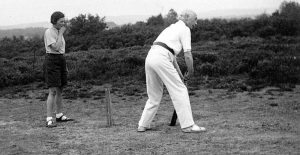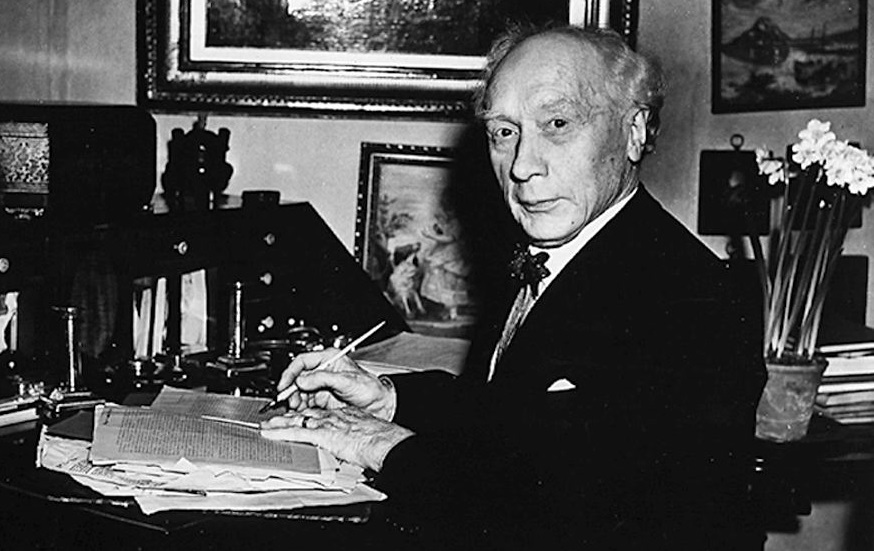The Alexander Technique as we know it today started with one actor’s vocal problem.
F.M. Alexander (F.M. as he was often called) was born in Tasmania, an island off the coast of Australia in 1869. As a young man, he was an aspiring actor. At the time, it was popular to recite Shakespearian monologues and he was on his way to making a name for himself.
But he had a problem. With his voice.
Quite simply, he would lose it. He would get hoarse when performing.
F.M. sought the help of medical professionals. They checked him over and couldn’t find anything obviously wrong. They suggested he rest his voice.
This worked, but as soon as he began to perform again, the pesky problem would return.
It was at this point that F.M. made his first important observation (in the form of a question that he asked himself).
Since at the beginning of a performance his voice was fine. And at the end it wasn’t, he asked himself wasn’t it possible that he was doing something during the performance to cause the loss of his voice?
He asked his doctors. They agreed that this was quite possible. But they, unfortunately, didn’t know what it was he was doing.
F.M. was not going to give up. He decided to see if he could figure out the answer to his question. He arranged mirrors in order to observe himself from several angles. He would recite. And he watched what he did.
What he noticed was his second important observation.
When he went to speak and project his voice, he would tighten his neck, pull his head back and down, depress his larynx, and audibly suck in air through his mouth (apparently this last thing he abhorred in other actors).
He also noticed a tendency to stiffen his whole body, pulling in his lower back, tightening his legs, and gripping the stage with his feet.
F.M. explored trying to keep one of these things in check and then another. What he found out was his third important observation: that it was what he was doing with his head that seemed to make all the difference. Like a master switch that affected everything else, if he was able to not tighten his neck and pull his head back and down towards his body, the rest of the stiffening seemed to take care of itself.
And most importantly his voice improved.
As he further explored projecting his voice and not tightening his neck, he realized that not only did speaking cause this unwanted habit to kick in, but just thinking about speaking caused the habit to rear its ugly head.
He realized that there was a connection between his thoughts and his actions—or his mind and his body. And he couldn’t ignore it if he wanted to solve his problem. The unity of mind and body was his fourth important observation. And he was way ahead of his time in realizing this and talking about it.
People noticed that F.M. had been able to help himself. And they started to seek out his help. He became known as “the Breathing Man” and helped people with breathing and vocal issues in Melbourne and later Sydney.
He soon found that he was able to help people not only with breathing and vocal issues but also with issues where current medical treatments weren’t effective—by addressing the underlying habits that were causing or exacerbating their symptoms.
Habits are pesky things. And if you’ve ever tried to change a habit, you’ll know it’s darn difficult.
Changing a habit involves doing something differently. But doing something differently, even slightly differently, often feels wrong. It’s hard to convince yourself to do something that feels wrong.
And even if you try to imitate or copy someone doing something, you’re not always doing what you think you’re doing.
Because of this F.M. started to use his hands to help his students. Over time he developed a way of teaching using gentle touch to communicate what he wanted his students to understand. This gentle hands-on approach is still a hallmark of Alexander teaching today.

F.M. moved to London in 1904 accompanied by a letter of recommendation from several prominent physicians. He quickly set up a successful practice. In 1931 he started to train others to teach what he simply referred to as the work. He died in 1955 at the age of 86.
Alexander wrote four books. If you’re a serious student of the Alexander Technique, you should at least try to read some of his writing. The books are not the easiest to read. F.M. loved very long sentences and he does tend to repeat himself. He was also a Victorian and his language reflects that.
In chapter 1 of the Use of the Self—Evolution of a Technique—Alexander narrates the process he went through to discover the source of his vocal trouble and devise a way of overcoming it.
If you read anything of his, read this chapter.

In 1958 the first professional society was formed in the U.K. (the Society of Teachers of the Alexander Technique or STAT). Today there are 18 affiliated professional societies worldwide, including the American Society for the Alexander Technique (AmSAT). I’ve been an active member since 2003.
Alexander teachers are now spread out across the globe, with large numbers in the U.K., Israel, Germany, and the United States.
Today the main reasons that people search out Alexander teachers fall into two broad categories:
Pain: back pain is one of the major reasons that people seek out the help of an Alexander teacher. But people also come for help with chronic neck and shoulder tension, headaches, and repetitive strain injuries. People who deal with chronic conditions such as arthritis, osteoporosis, or scoliosis can also benefit from learning tools to better manage their conditions on a day-to-day basis.
In 2008 a large randomized control study was done in the U.K. to study the effectiveness of Alexander lessons for people with low back pain.
Performance: People will come to get help performing better at a favorite activity, such as theater, dance, music, or athletics; or to simply do their everyday activities with more ease.
The Alexander Technique is frequently offered in many acting programs and music conservatories. Many famous actors have studied the Alexander Technique such as Annette Benning, Juliette Binoche, John Cleese, and Lynn Redgrave.
Once students experience improvement with what originally brought them in for lessons, they often see how the skills of the Alexander Technique can be used as a preventative tool going forward.
And that’s where I think the Technique’s true value lies. For it doesn’t just help you to solve your problems but gives you the understanding and skills to continue to take care of yourself for the rest of your life.
Ready to take the next step?
Photographs of F.M. Alexander © 2002 The Society of Teachers of the Alexander Technique, London

